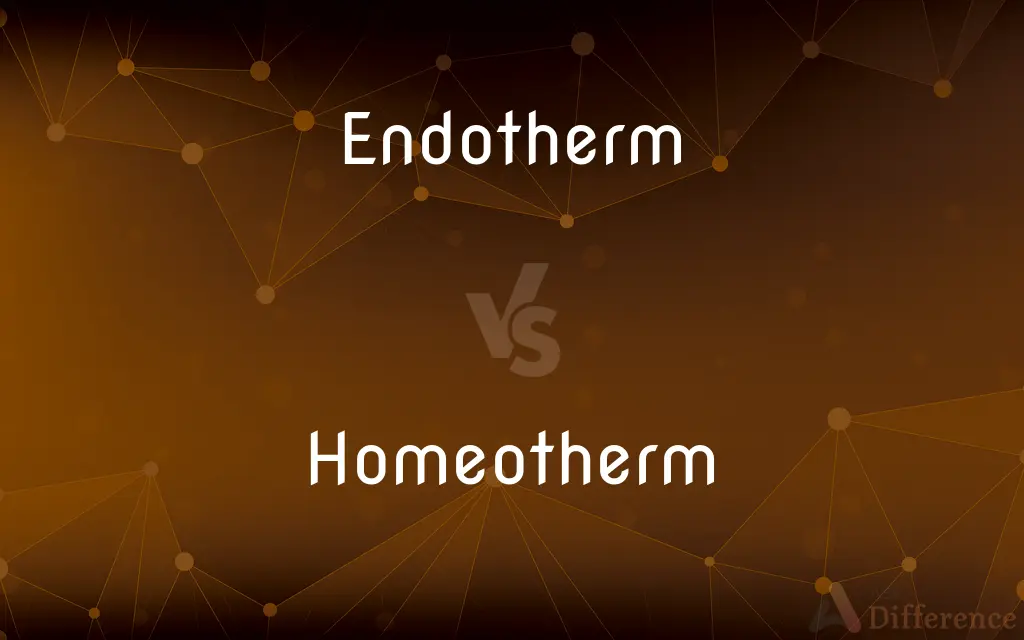Endotherm vs. Homeotherm — What's the Difference?
By Tayyaba Rehman & Urooj Arif — Updated on April 20, 2024
Endotherms generate their body heat internally, whereas homeotherms maintain a constant body temperature regardless of external conditions.

Difference Between Endotherm and Homeotherm
Table of Contents
ADVERTISEMENT
Key Differences
Endotherms are organisms that produce their own heat through metabolic processes, which allows them to remain active in a variety of temperatures. On the other hand, homeotherms are organisms that maintain a stable internal body temperature, a trait that can be found in both endotherms and some ectotherms under certain conditions.
The key advantage for endotherms is their ability to inhabit colder climates by generating body heat, which keeps them active when temperatures drop. Homeotherms, however, rely on both behavioral and physiological mechanisms to regulate their body temperature, ensuring functionality across different environmental conditions.
While all homeotherms are adept at temperature regulation, not all of them are endotherms. For example, certain fish and reptiles can maintain thermal homeostasis behaviorally by moving between sun and shade. This contrasts with typical endothermic animals like mammals and birds, which internally regulate their temperature metabolically.
One common misconception is that endothermy is synonymous with being warm-blooded, as it specifically refers to the source of the heat (internal), rather than the constancy of body temperature. Homeothermy, however, directly relates to the stability of the body temperature, not how it is achieved.
In terms of energy consumption, endotherms typically require more food and resources to maintain their metabolism and produce heat. Homeotherms, depending on whether they are endothermic or not, may require less energy if they can utilize environmental conditions to assist in regulating their temperature.
ADVERTISEMENT
Comparison Chart
Definition
Generates internal heat through metabolism.
Maintains a constant body temperature.
Example Organisms
Mammals, birds.
Mammals, birds, some reptiles, some fish.
Temperature Source
Internal metabolic processes.
Internal or external, depending on behavior.
Energy Use
High due to metabolic heating.
Varies; generally lower if ectothermic.
Climate Adaptation
Can adapt to colder environments.
Can stabilize temperature in varying climates.
Compare with Definitions
Endotherm
Typically associated with "warm-blooded" animals.
Most mammals are endotherms, keeping their body temperatures constant.
Homeotherm
Utilizes physiological and behavioral adaptations.
Homeotherms, such as bears, regulate their temperature through hibernation.
Endotherm
An organism that produces sufficient metabolic heat to raise its body temperature.
Birds are endotherms, which allows them to fly even in cold weather.
Homeotherm
Can be endothermic or utilize external thermal regulation.
Some desert reptiles are homeotherms, using the environment to help maintain temperature.
Endotherm
Requires high energy intake.
Endotherms, like wolves, need to hunt frequently to meet their metabolic needs.
Homeotherm
Found in various animal groups, including mammals and birds.
All mammals are homeotherms, though they achieve this through different means.
Endotherm
Generally found among birds and mammals.
All birds are endotherms, maintaining high body temperatures for flight.
Homeotherm
An organism that maintains a stable internal body temperature under different environmental conditions.
Penguins are homeotherms, keeping their body temperature steady despite icy waters.
Endotherm
Relies heavily on internal heat production.
An endotherm, such as a human, remains active in cold by generating heat internally.
Homeotherm
Often requires mechanisms like sweating or panting to regulate temperature.
Dogs pant to maintain a constant body temperature, characteristic of homeotherms.
Endotherm
An endotherm (from Greek ἔνδον endon "within" and θέρμη thermē "heat") is an organism that maintains its body at a metabolically favorable temperature, largely by the use of heat released by its internal bodily functions instead of relying almost purely on ambient heat. Such internally generated heat is mainly an incidental product of the animal's routine metabolism, but under conditions of excessive cold or low activity an endotherm might apply special mechanisms adapted specifically to heat production.
Homeotherm
An organism, such as a mammal or bird, having a body temperature that is constant and largely independent of the temperature of its surroundings.
Endotherm
An organism that generates heat to maintain its body temperature, typically above the temperature of its surroundings.
Homeotherm
A creature that maintains a stable internal body temperature regardless of external influence.
Endotherm
(biology) an animal that maintains a constant body temperature
Homeotherm
A homoiothermal animal.
Common Curiosities
What defines an endotherm?
An endotherm is defined by its ability to generate internal heat through metabolic processes to regulate its body temperature.
Are all birds homeotherms?
Yes, all birds are homeotherms, maintaining a constant body temperature through physiological means.
Why do endotherms need more food than ectotherms?
Endotherms need more food to fuel the metabolic processes necessary for generating heat internally.
Can an organism be an endotherm but not a homeotherm?
Theoretically, yes, if an endotherm has poor thermal regulation, but practically all endotherms are also homeotherms.
What is the advantage of being a homeotherm in variable climates?
Being a homeotherm in variable climates allows organisms to function optimally by keeping their internal temperature stable despite external changes.
How do homeotherms manage extreme temperatures?
Homeotherms manage extreme temperatures through adaptations like hibernation, migration, and changing blood flow.
How do endotherms differ from ectotherms in terms of habitat?
Endotherms can inhabit colder and more variable environments due to their internal heat generation, unlike ectotherms, which depend more on external heat sources.
How do aquatic homeotherms manage their body temperature?
Aquatic homeotherms, like whales, use insulating layers of fat and behavioral adaptations to manage their body temperature.
Is it more energy-efficient to be a homeotherm or an endotherm?
It is generally more energy-efficient to be a homeotherm that uses external factors to regulate temperature, compared to an endotherm that must continuously generate heat.
Which types of homeotherms are not endotherms?
Some types of fish and reptiles are homeotherms without being endotherms, using environmental heat sources to regulate their body temperature.
What role does metabolism play in endothermy?
Metabolism is crucial in endothermy, as it generates the heat needed to maintain body temperature.
Can the energy needs of homeotherms change with the environment?
Yes, the energy needs of homeotherms can fluctuate with environmental conditions, especially for those relying on external heat sources.
How does the body temperature of homeotherms affect their survival?
Stable body temperature helps homeotherms maintain physiological processes optimally, crucial for survival in fluctuating environments.
What are some common behavioral adaptations in homeotherms?
Common behaviors include sun basking, seeking shade, and altering body exposure to the elements.
What are some examples of homeothermic ectotherms?
Examples include certain species of sharks and tuna that maintain their body temperature above water temperature.
Share Your Discovery

Previous Comparison
Dizziness vs. Drowsiness
Next Comparison
Picture vs. PosterAuthor Spotlight
Written by
Tayyaba RehmanTayyaba Rehman is a distinguished writer, currently serving as a primary contributor to askdifference.com. As a researcher in semantics and etymology, Tayyaba's passion for the complexity of languages and their distinctions has found a perfect home on the platform. Tayyaba delves into the intricacies of language, distinguishing between commonly confused words and phrases, thereby providing clarity for readers worldwide.
Co-written by
Urooj ArifUrooj is a skilled content writer at Ask Difference, known for her exceptional ability to simplify complex topics into engaging and informative content. With a passion for research and a flair for clear, concise writing, she consistently delivers articles that resonate with our diverse audience.
















































